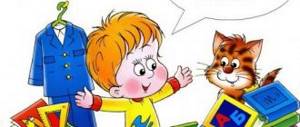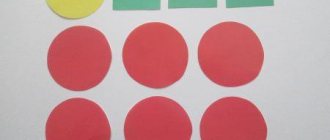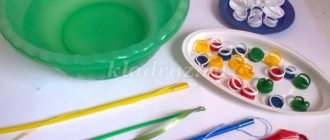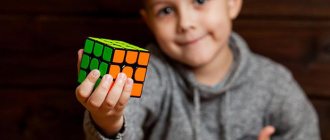06/29/2020 Category: Education without punishment
A sense of time is necessary for any person: the effectiveness of his activities largely depends on this. Like any ability, it is best to develop a skill in childhood. Knowing how to teach a child the time on a clock, and teaching him in the form of a game, you can help not only master the ability to navigate the parts of the day. The baby will become more disciplined, learn to plan his day, and become more punctual.
From this article you will learn
When to start
Children begin to feel the passage of time as soon as they are born, waiting for feedings and communication with their mother. Older kids watch how night follows day and associate familiar events: eating, walking, evening routines with dark and light times of day.
You can determine whether a child is ready to become familiar with the dial and hands by his ability to recognize numbers. If he can easily count to 60
and then, you know what double-digit numbers look like, you can start.
As a rule, this occurs by age 6
.
At this age, a preschooler has an understanding of the parts of the day and their features, and is aware of the concepts of “tomorrow,” “yesterday,” and “today.” He already has an established daily routine.
It’s good if the baby himself lets you know that he is interested in the movement of the clock by asking questions: “Is twenty minutes long?”, “When are we going for a walk?” At this point, parents should have a rough plan for teaching their child to tell time.
Card index of didactic games Section FEMP. Listing the parts of the day.
Card index of didactic games
FEMP section
Ordinal listing of parts of the day
Older age
Card No. 1
Didactic game “Name the day”
Target:
Strengthen ideas about the parts of the day (morning, afternoon, evening, night)
Materials
: cards depicting parts of the day.
Progress:
The teacher, together with the children, finds out how many parts a day consists of, offers to name them, show the corresponding pictures and lay them out in the correct sequence (Morning, afternoon, evening, night).
An adult offers to make up a day and names one of the parts of the day. Children list the remaining parts of the day and show the corresponding pictures. The game is repeated 2-3 times.
Card No. 2
Didactic game “When it happens”
Target:
consolidate knowledge about the parts of the day.
Material:
model of the day, pictures.
Progress:
The teacher sets up a model of the day, the arrow points alternately to different parts of the day - the children choose those pictures that depict the work activities of people carried out at this time of day. Sample questions: What is shown in the picture? Why did you choose this particular picture? What is this part of the day called?
Card No. 3
Didactic game “Day and Night”
Target:
consolidate children's knowledge about the parts of the day.
Progress of the game:
In the middle of the site, two parallel lines are drawn at a distance of 1-1.5 m. Both sides of them are the lines of houses. The players are divided into two teams. They are placed at their lines and turned to face the houses. The names of the “day” and “night” commands are determined. The teacher stands at the center line. He's the leader. At his command “Day!” or “Night!” - the players of the named team run into the house, and their opponents catch up with them. Those caught are counted and released. The teams line up again at the center lines, and the teacher gives a signal.
Option #2. Before giving a signal, the teacher invites the children to repeat various physical exercises after him, then suddenly gives a signal.
Option No. 3. The presenter is one of the children. He throws up a cardboard circle, one side of which is painted black, the other white. And, depending on which side he falls, he commands: “Day!”, “Night!”.
Card No. 4
Didactic game “What are you doing now?”
Target:
activating children's vocabulary through words-names of parts of the day.
Progress:
The teacher names a period of time and lists the corresponding
types of children's activities: “It’s morning. We did the gymnastics, washed ourselves and now
Let's have breakfast." Or: “We already had breakfast and worked out. It's already daytime.
We'll have lunch soon." The child is asked, for example: “It’s morning. What are you doing
in the morning? When you get up?" And so on.
Introducing the baby to the concept of “time”
The daily routine of young children is regulated by their parents, so they do not have the sense of time characteristic of adults. It is difficult for a child to immediately understand all the complexity of this category, so before he picks up a watch, he needs to be taught some terms. His task is to understand what a day, week, month is, what parts of the day there are, what today and yesterday mean.
You can help your child become aware of the passage of time at 2-3 years of age by drawing his attention to the sequence of events: first, then, now
. For example, first we washed our hands before eating, then we ate, and now mom washes the dishes.
Say what part of the day has arrived and what needs to be done: wash and have breakfast in the morning, play in the afternoon, read in the evening. Make a daily routine for the next day together, remember what you did yesterday.
Important
!
Pay attention to time intervals. You can do this by talking through your intended activities: in 5 minutes
we’ll go for a walk, we’ll go to bed
at 9 o’clock
,
in 15 minutes
it’s time for dinner.
Does a 4-5 year old child know what a day is and easily name its parts? This is a good indicator. If he is in difficulty, a colorful poster with a daily routine will help him, which depicts the usual actions characteristic of a particular time.
Once he has mastered the time of day concepts, he is ready to learn the days of the week. To consolidate the result, it is useful to ask your child more often what day of the week it was yesterday, what day it is today, what day it will be tomorrow.
For easy and quick learning, the following techniques are suitable:
- a selection of poems, songs, rhymes
about the days of the week and time of day; - drawings about time
: what was and what became, for example, a seed became a sprout, then a flower, an adult cat was a small kitten, etc.; - looking at a family album
with early childhood photographs; looking at his image at the age of one, the child realizes how he has changed; - watching cartoons or educational video lessons about time together.
For example, this cartoon very clearly shows what the essence of the learning process is. Show it to your child or see it yourself.
TRIZ plus
In previous articles, we found out that a systematic vision of the world around us, the ability to think systematically, is very important for a more accurate, more reliable, more complete and detailed perception of any object (subject, phenomenon, process). This perception allows us to find the best and most correct solution to emerging contradictions.
But working with the “Magic Screen” is quite difficult for preschoolers. Therefore, with the help of special games and exercises, it is necessary to prepare the child for the ability to think in a system, to show that any object is part of something larger and at the same time itself consists of something, changes in the process of moving from the past to the future.
While playing, we learn to understand the genetic approach (past-present-future)
"Locomotive" (technological chain)
We form in the child an idea of changes in an object over time. Depending on age, it increases the length of the chain - at 2-3 years old, two or three options are enough; the older the child, the longer and more complete the chain should be. For demonstration, you can use, for example, a train with carriages. We insert pictures into the window of the carriages or schematically draw a gradual change in the object over time.
Caviar → tadpole → frog
Egg → caterpillar → pupa → butterfly
Seed → sprout → sapling → small tree → big tree
If the game is played in a kindergarten, or there are several participants, the game can be made active. An adult prepares cards or pictures in advance, which are distributed to the players. These can be pictures depicting the seasons (for example: a green leaf, a yellow leaf, a branch without leaves, a branch with buds), different stages of a person’s life (baby, preschooler, schoolchild, adult, old person), the history of objects (cart, carriage, a vintage car, a modern car, a car of the future - for example, a flying one)
The “Train of Time” is lined up - the “Locomotive” gets up first, which, depending on age and understanding of the processes taking place, is either nominated by an adult, or the children choose themselves. Behind the “Locomotive” “Wagons” are lined up in accordance with the sequence of the process.
"What's first, what's next"
This exercise can be used with children 2-3 years old, gradually becoming more complex, and helps to consolidate the sequence of seasons, parts of the day, days of the week, etc.
- First autumn, and then? - Winter. - And then? - Spring. - And then? - Summer.
- First Tuesday, and then? - Wednesday.
- First evening, and then? - Night.
- First breakfast, and then? - Dinner.
With children 5-6 years old, you can use a multivariate approach:
- First clay, then... - vase, brick, sculpture, whistle, etc.
- First a log, then... - a house, a box, paper, a board, a closet, etc.
- First an egg, then... - a chick, a turtle, a baby crocodile, a caterpillar, a snake, etc.
If the game is played in a kindergarten group or with several children, and the principle of the exercise has already been mastered, then a new rule can be introduced - whoever names the last word from the answer options becomes the leader and offers his first word.
"Paired words"
With this exercise you can reinforce the names of animals and their young, the processes of human maturation, changes in living and inanimate nature. The exercise is carried out in direct (now-later) and reverse (now-before) versions in paired words. The game will be more interesting if you throw the ball to each other. In this case, in addition to consolidating knowledge, the child practices catching and throwing a ball, coordination of movements is improved, and both hemispheres of the brain are activated due to simultaneous mental and motor activity.
With younger children, the topic is called: for example, “What is the name of the baby?”
The adult says the word: “Horses” and throws the ball to the child. The child catches it, answers: “Falk” and throws the ball back to the adult. Adult: “Cats”… “Kitten”; “Pigs”… “Piglet”; “Dogs”… “Puppy”, etc.
With older children (from 6-7 years old), a specific topic may not be indicated, only the direction “What happened before?” or “What will happen?” Words are taken from different topics: for example, “What happened before?”
"Day...morning"; "Sheep...lamb"; "Flower...seed"; “Uncle... boy”; "Rain...cloud"; “Window... glass”, etc.
For older preschoolers - “Timeline”
.
Printed board games for kids
In stores you can purchase ready-made games, for example “What first, what next”, “Logic chains”, etc.
You can download the two proposed games, print them on a color printer, cut them into cards (you can pre-glue them onto cardboard) and play with your child.
"What's first, what's next"
By completing tasks, the child learns to generalize, understand the sequence of the plot, cause-and-effect relationships, and develop attention, observation, and coherent speech.
Option 1: The child is asked to put the pictures in order in a certain sequence. First you need to sort out the plots consisting of 4 pictures, then - from 6, after that - from 8. Then compose detailed stories based on the pictures. If a child has difficulty composing a story, you can help him by starting a story.
Option 2: Children are invited to look at any picture from any series and come up with the beginning and end of their story based on this picture.
Option 3: Children are invited to look at any picture from any series and make a sentence based on it using 2, 3, 4, etc. words Then compose a story consisting of one, two, three sentences. You should pay attention to the coherence of speech, its expressiveness, and emotionality.
"LOGICAL CHAINS"
This is an educational game for preschool children, with the help of which the child will learn to find relationships between objects and phenomena, develop logical thinking and coherent speech.
There are other very interesting and useful games and books that help a child develop ideas about the variability of objects over time.
For example, Natalia Rodina’s book “What First, What Then”
The purpose of this book is to give children the opportunity to feel like researchers to some extent. An ordinary story about certain things is accompanied by a chain of pictures, which the child himself must arrange in a logical sequence in order to reproduce the process of obtaining a particular product. Thanks to such work, the child learns to compare, analyze, establish cause-and-effect relationships, make inferences, etc., which forms the basis of logical thinking.
Another game "What's first, what's next"
— one of the assistants in preparing a child for school. During the game, he learns to coherently express his thoughts, compose long sentences, determine cause and effect in the proposed situation.
Did you like the article? Share with your friends
Let's start studying watches
The best model for learning is a model with a large dial and clear numbers. It is better if they are round, without distracting decor. You can make the model yourself from thick cardboard together with your child.
Training steps:
Advice
. It’s easier for a child to understand how the hand works by looking at a poster that depicts an activity next to each hour: a game, breakfast, a walk. It is advisable that the picture coincides with the child’s daily routine. When planning to perform this or that action, correlate it with the time shown on the poster.
Games to consolidate results
Reinforce your learning with simple practical tasks in a playful way. When performing a certain action: going to bed, waking up, setting the table for dinner, ask your child to watch and tell you what time the clock shows.
When turning on cartoons, a computer game, going on a visit or for a walk, clearly state the planned time interval: 15 minutes, half an hour, an hour - and pay attention to the location of the arrows.
Ask your child for help when doing household chores, for example, ask him to remind you to turn off the stove in 5 minutes, say that it’s time for dinner if the big arrow is on the number 6. Teach punctuality: when going somewhere, talk about the time for getting ready and traveling .
Here are some ways to master time categories playfully:
Game "Yesterday, Today, Tomorrow"
The goal is to introduce children to the concepts of “yesterday,” “today,” and “tomorrow.”
Material: multi-colored stripes, a selection of poems.
Progress of the game: The teacher explains that every day, in addition to its name, has another name (yesterday, today, tomorrow).
The day that has come is called today.
A day that has already ended is yesterday.
And the day that is yet to come is tomorrow.
We designate the colors (stripes): today – blue, yesterday – blue, tomorrow – purple.
First, we fix the color designation: the teacher names the concepts, the children show the corresponding strip.
Then the teacher reads the poem, the children determine what day the poem is about (yesterday, today, tomorrow) and show the corresponding strip.
Working with the “Yesterday, Today, Tomorrow” block
The goal is to consolidate ideas about the present, past, and future time (the concepts of “yesterday,” “today,” “tomorrow”).
Material: strip (block), divided into 3 squares, each square contains Velcro, picture cards.
Progress of the game:
The teacher shows the children the block and explains that every day something interesting happens. This interesting thing can be noted in the block. Under the inscriptions yesterday, today, tomorrow there are empty squares with Velcro. We will hang cards on this Velcro that depict what we did during a certain day.
For example:
- What we did today: we drew - we hang up a card that means drawing.
- Let's remember, what did you do yesterday? - went to the store. We hang up a certain card.
- Now let's think about what you will do tomorrow? - Tomorrow you will go to the circus.
It is necessary to draw children's attention to what has already happened, pronounced in the past tense - they went, they bought. What is happening at the moment is said differently - let's go, buy. What is yet to happen - let's go, let's buy.
Ball game "Yesterday, today, tomorrow"
The goal is to determine the level of children’s ability to navigate in time, to consolidate ideas about the concepts of “yesterday,” “today,” and “tomorrow.”
Material: ball
Progress of the game: The teacher throws the ball to the children one by one, saying a short phrase, for example: “We are doing...” The child who caught the ball finishes the phrase (... today).
Example phrases:
We are going to walk…
Did you go to the park...
We will read a book...
Game-task “What happened before, what happened next”
The goal is to consolidate ideas about the present, past, and future time.
Material: set of pictures.
Progress of the game: The teacher invites the children to put the pictures in order and tell what happened before and what happened next.
Exercise “House of Days”
The goal is to consolidate ideas about the present, past, and future time (the concepts of “yesterday,” “today,” “tomorrow”).
Material: a house with three windows, multi-colored stripes, a selection of poems.
Progress of the game: The teacher invites the children to look at the house and says that this is a “house of days.”
Tasks:
- What is the name of the day that has already passed? (yesterday) He settled in the lower window. (insert the blue stripe into the bottom pocket)
- What is the name of the day that we have now, at the present moment? (Today). He occupied the middle window (insert a blue stripe)
- What is the name of the day that is coming soon? (tomorrow) He settled in the upper window (insert a purple stripe).
The teacher reads a poem to the children and invites the children to “place the poem” in the appropriate window.
Days of the week
Working with the “DAYS OF THE WEEK” clock:
The goal is to give an idea that 7 days make up a week, to reinforce the names and sequence of the days of the week.
Material: clock “Days of the week” with numbers 1-7.
Progress of the game: The teacher shows the children a circle on which the days of the week are depicted. He says that this circle is called a “week”, there are only seven days in a week, each day has its own name. Each day of the week is a different color (the color of the rainbow), when naming the day, it rearranges the arrow and draws the children’s attention to the number:
Monday is the first day, it starts the week.
Tuesday is the second day.
Wednesday is the day of the week in the middle of the week, the middle.
Thursday is the fourth day.
Friday is the fifth day.
Saturday - work is over, on this day mom and dad rest and don’t go to work.
Sunday is the very last day of the week, the seventh.
Then the teacher invites the children to name the days of the week in order, rearranging the arrow. Children name the number and the corresponding day of the week.
Tasks:
1. The teacher asks the children to name the days of the week in different orders.
(What is the name of the first day of the week? What is the name of the fifth day? Etc.
On what days do mom and dad don’t go to work, and you don’t go to kindergarten?)
2. The teacher names the day of the week. And the child must name the day that was first (yesterday) and will be later (tomorrow) - thus, the following time concepts will be further consolidated - yesterday, today, tomorrow.
"Colorful Week"
The goal is to consolidate the names and sequence of days of the week, their color correlation.
Material: multi-colored circles, numbers from 1 to 7.
Progress of the game: The teacher indicates the color on the demonstration circle and names the day of the week, the children show the corresponding number.
Option. The teacher shows the numbers from 1 to 7 in order, the children show the corresponding color on their circles and name the day of the week.
Game "Live Week"
The goal is to consolidate the names and sequence of days of the week, their color correlation.
Material: pictures - gnomes in clothes of different colors.
Progress of the game: The teacher tells the children that gnomes have come to visit them. Their names are like the days of the week. Shows a picture with the first gnome: “I am Monday. Who is next?" The children name, the teacher displays the next gnome: “I am Tuesday. Who is next?" etc. At the same time, the teacher draws the children’s attention to the color of the gnomes’ clothes.
Tasks:
1. The teacher asks the children to put the gnomes in order and say their names.
2. The teacher asks the children to name the names of the gnomes:
- What is the name of the gnome who is between Tuesday and Thursday, Friday and Sunday, after Thursday, before Monday, etc.
"A week, get ready"
The goal is to consolidate the names and sequence of the days of the week
Material: numbers 1-7.
How to play: There are upside-down cards with numbers on the table. Children take cards from the table at a signal. They look for their partners, that is, they line up in order and name their day of the week (“The first is Monday, the second is Tuesday….).
Tasks:
1. The teacher asks to leave the day that represents Monday;... Wednesday, etc.
2. The teacher asks for the day of the week that comes after Monday, before Saturday, between Tuesday and Thursday, etc.
3. The teacher asks to come out the days of the week that are after Thursday (children with the numbers five, six, seven come out); before Wednesday (children with numbers one, two) and name their days of the week.
Game-task “Dunno's Week”
The goal is to consolidate the names and sequence of the days of the week
Material: doll or picture “Dunno”.
Progress of the game: The teacher tells the children that Dunno has come to visit them.
Help Dunno name the days of the week. Dunno called it this way: “Sunday is a day of fun... Then Wednesday - but this is nonsense... Then Saturday - hunting for a walk. That's all!" Did Dunno name the days of the week correctly?
Children correct Dunno's mistakes.
Seasons.
Why do you need to teach your child to tell time?
Imagine that you cannot navigate time at all.
You don't know when you need to go to work, when to return home, when it's lunch, or what time you go to bed and wake up. Also, your baby does not understand how long it takes for his mother to pick him up from kindergarten. He may be capricious if you tell him to wait five minutes, because he does not understand how long it is, he may have to wait all day.
If the baby has grown to the age when he can be left alone at home, you tell him that you will return in two hours, and without the ability to tell the time by a dial, the child will be confused, he will not know how long his mother will not be around.
In order for your baby to be able to navigate all these things, and also be more disciplined, as well as ready for school, he needs to be taught how to tell time using a clock.
Where to begin? Basic principles of teaching time
First, explain to your child the general concept of time.
Say that it moves only forward, and also has its own components: years, months, weeks, days, hours, minutes, seconds. Remember the concepts with which the baby is familiar - day and night. Explain that together, day and night represent a day that lasts the same amount of time each day—24 hours.
Tell us that there is a morning when the baby wakes up and has breakfast, a day when the baby has lunch and goes to bed, an evening when he needs to have dinner and get ready for bed, and the whole night when the baby sleeps.
Explain that parents use a clock to determine when it is time to get up, eat, or go to bed.
Show your child the watch and tell him what is on it. Count all the lines with your child and explain that each of them is a minute. How many minutes can you count on the dial? That's right, 60. When the long hand passes 60 lines, one hour has passed, and the large numbers show how many hours have passed.
What's first? What then?
Target. Teach children to coherently express their thoughts, compose complex sentences, and determine cause and effect in a given situation. Learn to build sentences using words because, because of that, therefore. Develop an understanding of simple cause-and-effect relationships. The set includes a series of pictures depicting simple everyday scenes. The child must understand what is the cause and what is the consequence of what is shown in the pictures. The material can be used to master prepositional-case constructions.
Tasks. Learn to compose a story, expand the child’s vocabulary, develop logical thinking and coherent speech; learn to systematize acquired knowledge.
Exercises with clocks
Make a clock with your child from multi-colored cardboard.
The arrows can be screwed on using a nut and bolt, or you can come up with another method. While making the watch, tell your child what all these dashes and numbers mean; that the small hand is the hour hand. She moves slowly from number to number; the big one is minute, it moves faster, and when it goes full circle, it means that an hour has passed. Previously, parents would draw a dial on cardboard for their children, or shake a clock in front of them, trying to explain what a time line is and why there are seven days of the week. This set includes the most effective ways to study time, days of the week and seasons, teach your child to build his own plan and calendar. It was developed by methodologists of the School of the Future, so with it your child is ahead of the rest.
Opening the box
And in it there is a conveniently laid out magnetic board, similar to the page of some cool mobile application: a clock, a calendar, and other slots that the child will fill out independently. You can even draw on it, not only place magnets.
The workbook contains both theory and practice, various tasks, and illustrated exercises. You can practice it gradually, starting with the simplest. Moreover, children can do this on their own; their older brothers and sisters and parents can only help a little with reading the assignments.
Games make the learning process interesting and exciting, and changing activities for a long time does not tire even the youngest children. Take cards and match nature photographs with magnets with the time of year or day. Discuss what you are doing today, what you did yesterday, and what your plans are for tomorrow - this is how the child, through pictures, realizes the existence of different plans of reality.
Didactic games in raising children
Didactic games in raising children
The article was prepared by a teacher
kindergarten No. 250 Lyudmila Viktorovna Zarubina
A game is a specific, objectively developing ability, activity that is used by adults to educate preschoolers, teach them various actions, methods and means of communication.
We must remember that the game always has two aspects - educational and cognitive. In both cases, the goal of the game is formed not as the transfer of specific knowledge, skills and abilities, but as the development of certain mental processes or abilities of the child.
In play, a child’s psyche is formed, on which it depends how much he will subsequently succeed in school, work, and how his relationships with other people will develop.
The game is a fairly effective means of developing such qualities as organization, self-control, and attention. Its rules, mandatory for everyone, regulate the behavior of children and limit their impulsiveness.
For a child, play is a way of self-realization. In the game he can become what he dreams of being in real life: a doctor, driver, pilot, etc. In the game, he acquires new knowledge and refines his existing knowledge, activates his vocabulary, develops curiosity, inquisitiveness, as well as moral qualities: will, courage, endurance, and the ability to yield. The game develops an attitude towards people and life. The positive attitude of games helps to maintain a cheerful mood.
A large place in working with preschool children is given to didactic games . They are used in classes and in children’s independent activities. A didactic game can serve as an integral part of the lesson. It helps to assimilate, consolidate knowledge, and master the methods of cognitive activity.
The purpose of the didactic game is to soften the transition from one leading activity to another, as well as to make it easier for children to acquire knowledge and ideas about the world around them.
Each game is a child’s communication with adults, with other children; it is a school of cooperation in which he learns to both rejoice in the success of his peers and to endure his own failures. Kindness, support, a joyful atmosphere, inventions and fantasies - only under such conditions will games be useful for the development of the child. I offer options for games aimed at the mental development of a child while preparing him for school.
Game that develops memory
“Drawing patterns from memory”
The game is aimed at developing visual memory. A pattern is drawn on a piece of paper. Ask your child to look at this pattern for two minutes. After this, remove the pattern and offer to reproduce it from memory.
Games that develop logical thinking
"Zoological Lotto"
Who lives in the water, in the land, in the desert, in the north, in the forest, in the jungle? From a set of proposed pictures, children choose the ones they need.
“What does anyone need?”
Each child chooses a card with a picture of a person of some profession and selects the appropriate tools.
“When does this happen?”
The child chooses a card with a picture of a season and matches it with other cards (pictures of nature, what people are doing, what children are playing, etc.).
“What’s extra?”
The child is given a number of items. He should highlight the excess. Questions asked:
1. What's extra?
2. Why? Name a distinctive feature.
Games that develop speech
“Who knows, let him continue”
Goal: to learn to select and use words with a general meaning in speech, to correlate generic and specific concepts.
Option 1:
An adult names a generic concept - a word with a general meaning, children - words related to a given gender, with a specific meaning.
Presenter: furniture.
Children: bed, sofa, chair, table, etc.
Presenter: fish
Children: carp, crucian carp, ruff, pink salmon, etc.
(Fruits, trees, vegetables, birds, etc.)
"Vice versa"
Goal: enriching the child’s vocabulary with antonyms.
Chips are required to play.
The presenter names the words, and the participants select words with the opposite meaning. For the correct answer they get a chip.
- Kind angry; polite - rude; neat - sloppy.
- Back and forth; high - low; narrow – wide; up down; right left.
- Day Night; friend - enemy; brave is a coward.
A game that develops attention
"Edible - inedible"
Select pictures depicting various objects - some of them should be edible. Explain to your child that you will show the picture one by one, and they will clap their hands if the picture shows something that can be eaten.
You can use the ball game option. You throw the ball and name the object. If it is edible, the child catches the ball, if it is inedible, he hits it.
The first option develops visual attention, and the second – auditory attention.
Dear parents, some of these games do not require a lot of time or special conditions. You can play these games with your child on the way to kindergarten, sitting at home on the sofa in moments of relaxation. Pay more attention to your children, love them, and they will answer you in kind.







